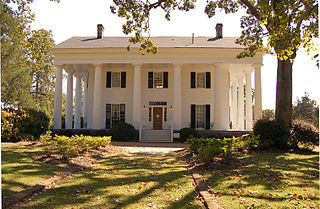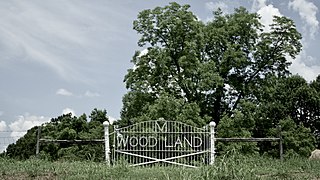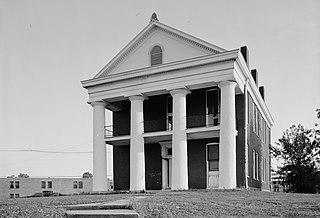Related Research Articles

Natchez is the only city in and the county seat of Adams County, Mississippi, United States. It has a total population of 14,520. Located on the Mississippi River across from Vidalia in Concordia Parish, Louisiana, Natchez was a prominent city in the antebellum years, a center of cotton planters and Mississippi River trade.
A plantation house is the main house of a plantation, often a substantial farmhouse, which often serves as a symbol for the plantation as a whole. Plantation houses in the Southern United States and in other areas are known as quite grand and expensive architectural works today, though most were more utilitarian, working farmhouses.

Samuel Sloan was a Philadelphia-based architect and best-selling author of architecture books in the mid-19th century. He specialized in Italianate villas and country houses, churches, and institutional buildings. His most famous building—the octagonal mansion "Longwood" in Natchez, Mississippi—is unfinished; construction was abandoned during the American Civil War.

Longwood, also known as Nutt's Folly, is a historic antebellum octagonal mansion located at 140 Lower Woodville Road in Natchez, Mississippi, United States. Built in part by enslaved people, the mansion is on the U.S. National Register of Historic Places, and is a National Historic Landmark. Longwood is the largest octagonal house in the United States.

Faunsdale Plantation is a historic slave plantation near the town of Faunsdale, Alabama, United States. This plantation is in the Black Belt, a section of the state developed for cotton plantations. Until the U.S. Civil War, planters held as many as 186 enslaved African Americans as laborers to raise cotton as a commodity crop.

David Ker, born in northern Ireland, was a minister, educator, lawyer and judge, the first presiding professor of the University of North Carolina.

Winter Quarters in Tensas Parish, Louisiana, United States, is a surviving example of an antebellum cotton plantation. It is located south of Newellton on Lake St. Joseph, an ox-bow lake, or former bend in the Mississippi River.
Judge Jeremiah Watkins Clapp was a slave-owning American lawyer, planter and politician. He owned cotton plantations in Mississippi and Arkansas, and he served as a judge in the Mississippi legislature from 1856 to 1858. An advocate of the Confederate States of America, he served in the First Confederate Congress from 1862 to 1864. During the American Civil War, he was in charge of Confederate cotton in Mississippi as well as sections of Alabama and Louisiana. After the war, he moved to Memphis, Tennessee, and he served in the Mississippi State Senate from 1878 to 1880.

Antebellum architecture is the neoclassical architectural style characteristic of the 19th-century Southern United States, especially the Deep South, from after the birth of the United States with the American Revolution, to the start of the American Civil War. Antebellum architecture is especially characterized by Georgian, Neo-classical, and Greek Revival style homes and mansions. These plantation houses were built in the southern American states during roughly the thirty years before the American Civil War; approximately between the 1830s to 1860s.
William Ellison Jr.(April 1790 – December 5, 1861), born April Ellison, was a USA cotton gin maker and blacksmith in South Carolina, and former African-American slave who achieved considerable success as a slaveowner before the American Civil War. He eventually became a major planter and one of the wealthiest property owners in the state. According to the 1860 census, he owned up to 68 black slaves, making him the largest of the 171 black slaveholders in South Carolina. He held 63 slaves at his death and more than 900 acres (360 ha) of land. From 1830 to 1865 he and his sons were the only free blacks in Sumter County, South Carolina to own slaves. The county was largely devoted to cotton plantations, and the majority population were slaves.

Plantation complexes were common on agricultural plantations in the Southern United States from the 17th into the 20th century. The complex included everything from the main residence down to the pens for livestock. Until the abolition of slavery, such plantations were generally self-sufficient settlements that relied on the forced labor of enslaved people.
Joseph Emory Davis was an American lawyer who became one of the wealthiest planters in Mississippi in the antebellum era; he owned thousands of acres of land and was among the nine men in Mississippi who owned more than 300 slaves. He was the elder brother of Jefferson Davis and acted as his surrogate father for several years. The younger Davis became a politician, U.S. Senator, and later President of the Confederacy.

The Woodland Plantation is a historic Southern plantation near Church Hill, Jefferson County, Mississippi. It retains its original antebellum 230 acre size, and has the tradition of primarily supplying hay to the area cattle. It also has a pecan orchard.

Stephen Duncan was an American planter and banker in Mississippi during the Antebellum South. He was born and studied medicine in Pennsylvania, but moved to Natchez District, Mississippi Territory in 1808 and became the wealthiest cotton planter and the second-largest slave owner in the United States with over 2,200 slaves. He owned 15 cotton and sugar plantations, served as President of the Bank of Mississippi, and held major investments in railroads and lumber.

Edward McGehee was an American judge and major planter in Wilkinson County, Mississippi. He owned nearly 1,000 slaves to work his thousands of acres of cotton land at his Bowling Green Plantation.
John Ker (1789–1850) was an American surgeon, planter and politician in Louisiana. Together with several major Mississippi planters, in the 1830s Ker co-founded the Mississippi Colonization Society, promoting removal of free American blacks to a colony in West Africa. The state group modeled itself after the American Colonization Society, where Ker later served as a vice president.

Thomas Affleck was a Scottish-American nurseryman, almanac editor, and agrarian writer and Southern planter. He published the Southern Rural Almanac and Plantation and Garden Calendar from 1851 to 1861.

Oakland College was a private college near Rodney, Mississippi. Founded by Dr. Jeremiah Chamberlain in 1830, the school was affiliated with the Presbyterian Church. It closed during Reconstruction, and some of its former campus is now part of the Alcorn State University Historic District.
Petit Gulf cotton was a cotton hybrid patented by planter Rush Nutt at his Laurel Hill Plantation in Rodney, Mississippi, in 1833. It was named "Petit Gulf" for the bend of the Mississippi River where it was grown. It proved more resistant than the green seed cotton from Georgia as long as planters followed the breeding process used in Rodney. Indeed, it was said to be less likely to harbor diseases and rot than other breeds of cotton. Moreover, it was easier to pick with a human hand, thus leading to greater productivity.
Rush Nutt (1781–1837) was a Mississippian planter, physician, and scientist. He was the founder of Laurel Hill Plantation and discovered Petit Gulf cotton. He is a former justice of the Jefferson County court in Mississippi.
References
- 1 2 3 4 5 6 7 8 9 10 11 12 13 14 15 16 17 18 19 20 21 22 23 24 25 26 27 28 29 30 "Pilgrimage Historical Association Collection: Nutt Family Papers 1841-1911". Mississippi Department of Archives and History. Archived from the original on 2011-07-22. Retrieved 2008-07-14.
- ↑ Named in Richard Nutt's will, Northumberland Co., VA Record Book 19, p. 107.
- 1 2 "The Haller Nutt Claim. The Findings of the Court Reported to Congress". The Evening Times. Washington, D.C. December 20, 1899. p. 4. Retrieved December 28, 2015– via Newspapers.com.

- ↑ James, D. Clayton (1993). Antebellum Natchez. LSU Press. p. 158. ISBN 978-0-8071-1860-3.